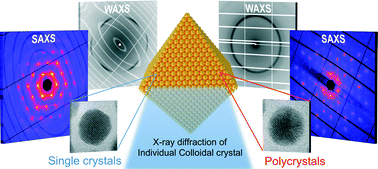Polymorphism in nanoparticle-based crystals depending upon their single or polycrystalline character†
Abstract
Colloidal single crystals of submillimeter size (colloidal crystal) are built by self-assembly of gold nanoparticles with nearly similar size (ca. 5 nm) but different nanocrystallinities. The external shape of the gold nanoparticles was characterized using electron microscopy and related to their nanocrystallinity. A synchrotron-based experiment is used to collect X-ray diffraction patterns from individual single crystals over the wide q-range relevant to both interatomic and interparticle periodicities. This makes possible a detailed reconstruction of the reciprocal space including diffuse scattering. X-ray diffraction demonstrates that colloidal crystals made up of single-crystal nanoparticles belong to the body-centered cubic system while face-centered cubic single crystals are observed in the case of self-assembly by polycrystalline particles. A remarkable feature is the preferential orientation of the symmetry axes of the single-crystal nanoparticles along those of the colloidal crystal; on the contrary, polycrystalline nanoparticles display random orientation. These results show the importance of the nanocrystallinity for the packing behavior.


 Please wait while we load your content...
Please wait while we load your content...